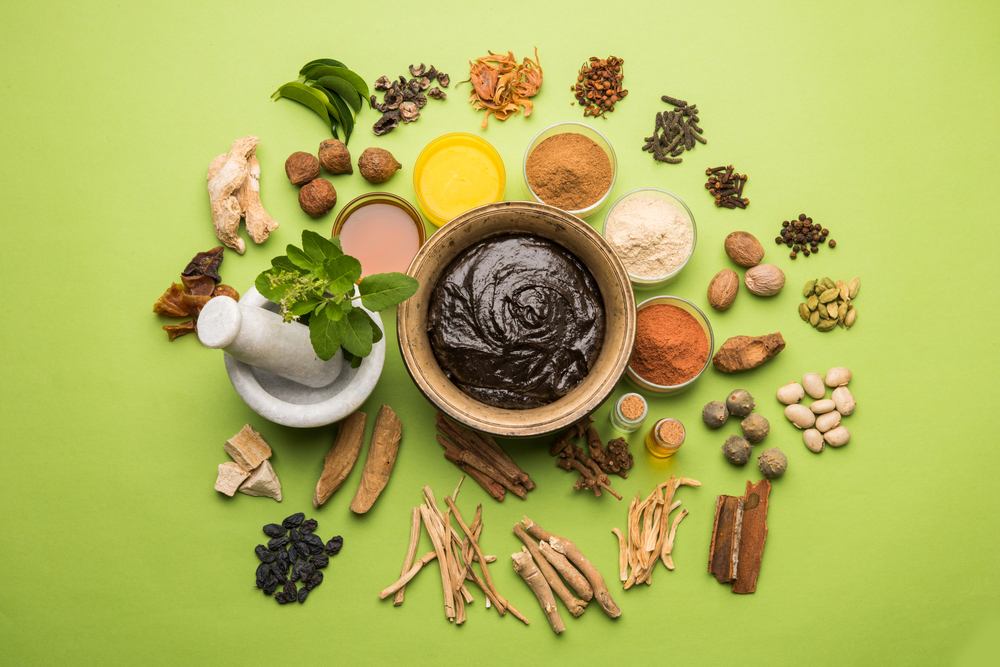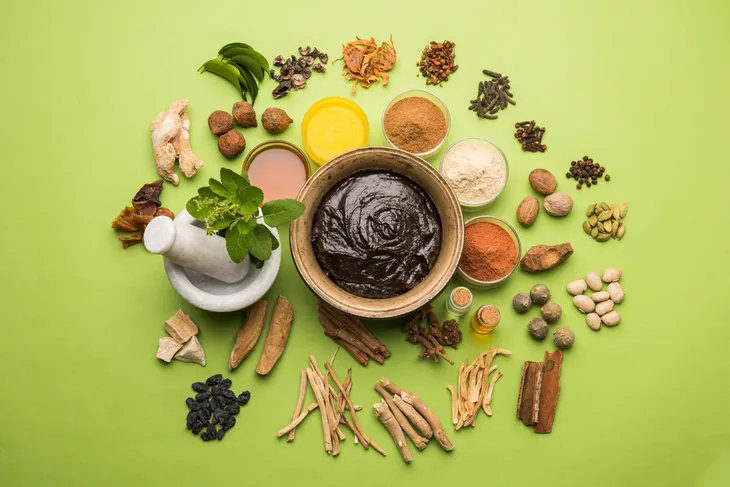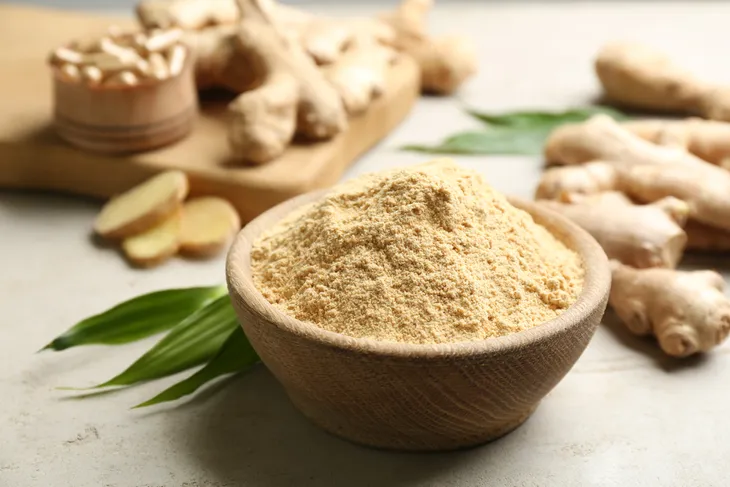- High uric acid levels can lead to health concerns like joint pain, gout, and kidney stones.
- Ayurvedic herbs may help control uric acid levels when taken orally or used topically.
- Here are seven Ayurvedic herbs to check out, plus more ways to reduce uric acid levels.
If you have high uric acid levels, then you might deal with inflammation and joint pain. Uric acid is a natural waste product “created when the body breaks down chemicals called purines,” says the Cleveland Clinic. It’s typically expelled in urine, but sometimes the body produces too much or doesn’t eliminate enough of it.
When too much uric acid stays in the body, the source says urate crystals can form. Those crystals can settle into joints, causing pain and swelling. Fortunately, some remedies and lifestyle changes can help control uric acid levels. Let’s take a look at the options!
What Is Ayurveda?
Ayurvedic herbs are a natural remedy for high uric acid levels and related conditions like gout. But first: what is Ayurveda? According to TODAY, it’s a “holistic medical healing system designed to align the mind, body and nature.” The term translates to the “science of life.”
It “involves dietary practices to create harmony between your individual energy patterns and universal elements,” says the source. While it’s been around for centuries, celebrity practitioners like Gwyneth Paltrow and Kourtney Kardashian have helped pique a resurgence of interest.
Punarnava
Now that you know the basics of Ayurveda, we can get into the details of Ayurvedic herbs. Punarnava, for example, is one of the herbs that may help manage uric acid levels. Tata 1mg says that’s because it has diuretic properties.
As a result, punarnava can increase urine flow and help expel excess uric acid. The source suggests adding 1- to 2-teaspoons of punarnava juice to a glass of water. Drink the concoction once or twice a day. Of course, you should talk with your doctor before trying any of these remedies.
Guggul
Guggul is another Ayurvedic herb that may help those with high uric acid levels. Instead of acting as a diuretic, it acts as a pain reliever. According to Tata 1mg, guggul can “reduce swelling, pain and stiffness in joints.”
For that reason, it can help with conditions related to elevated uric acid levels like gouty arthritis. The source suggests taking 1 to 2 guggul tablets a day with water. Alternatively, you could mix guggul powder with water.
Giloy
Giloy, also known as guduchi and amrita, should also be on your radar. According to Healthline, it may help in two ways. Firstly, research suggests that giloy neutralizes high uric acid levels in the body.
Secondly, a different study shows that giloy has anti-inflammatory and pain-relieving properties. So, it comes at the issue from a couple of angles. Tata 1mg suggests combining 2- to 3-teaspoons of giloy juice with water once or twice a day.
Nagarmotha
Nagarmotha is known by several names around the world — for example, nut grass, musta, and motha are just a few of its names. But whatever you call it, nagarmotha is another herb that can help manage symptoms of high uric acid.
According to Netmeds, “nagarmotha offers extensive relief from pain and inflammation” in joints. While it can be taken orally, the source suggests making a topical paste. Mix nagarmotha, ginger, and punarnava with water to do so. Then apply the mixture to the affected area a few times a day.
Varun
In addition to gout, high uric acid levels can also lead to kidney stones. That makes varun another useful Ayurvedic herb because Tata 1mg says it may help reduce “the tendency of stone-formation in the kidneys.”
The source suggests combining 1-teaspoon of varun powder with honey. Then consume the mixture after a meal. Additionally, varun may help reduce joint pain topically. The source says to mix 1-teaspoon of varun bark powder with coconut oil to make a paste.
Ginger
Ginger, also called shunthi, is often recommended as a natural remedy for gout — and it’s easy to understand why. Healthline says it may relieve pain related to uric acid when applied topically, and it may reduce uric acid levels when taken orally.
The source recommends steeping 2-teaspoons of ginger root for 10-minutes in boiling water to consume it internally. And if you want to use it topically, then the source says to soak a washcloth in a mixture of boiled water and grated ginger root. Once it cools, place the washcloth on the affected area for 15- to 30-minutes.
Turmeric
If you experience joint pain, then turmeric is another option to consider. Healthline says that’s because its active compound is curcumin. As a result, turmeric has anti-inflammatory properties, which can help reduce swelling and, in turn, joint pain.
So, how can you take turmeric? The source suggests adding it to a variety of dishes, including curry, soup, eggs, and smoothies. Alternatively, you could drink turmeric tea or take supplements. Some turmeric supplements even contain ginger.
More Ways to Reduce Uric Acid and Joint Pain
Ayurvedic herbs aren’t the only thing you can try. Other dietary and lifestyle adjustments can also make a difference. For instance, some foods like red meat and seafood are high in purines. So, identifying high-purine foods to cut back on is one of the other measures that can be beneficial.
While home remedies and lifestyle adjustments can help, we should note that medications are often prescribed to manage uric acid levels and treat gout. Talk to your doctor if you want to learn more about prescription medications. And keep reading to learn more about home treatments!
Up Your Water and Fiber Intake
You’ve probably heard you should drink more water and consume more fiber for your general health. But it turns out that both measures can help manage uric acid levels. It makes sense — water and fiber help flush waste products like uric acid out of the body.
Healthline suggests carrying a water bottle with you to make it easier to increase your intake. Then you’ll be reminded throughout the day to stay hydrated. When it comes to getting enough fiber, the source recommends adding at least 5- to 10-grams of soluble fiber to your daily diet.
Watch Out for Purines in Your Diet
As previously mentioned, some foods are especially high in purines. Since the body creates uric acid when it breaks down purines, it’s a good idea to watch out for just how many purine-rich foods you consume.
WebMD says the following types of food are high in purines:
- Pork, red meat, and lamb
- Seafood like shrimp and lobsters
- Organ meats like kidneys and liver
- High-fructose soda, cereal, etc.
- Beer and grain liquors like vodka
Be sure to talk with your doctor before making significant changes to your diet.
Lifestyle Changes Can Also Help
Staying active, reducing stress, and getting more sleep can also help control uric acid levels and reduce joint pain by keeping inflammation in check. Several low-impact exercises are joint-friendly. For example, walking and cycling can strengthen joints. Yoga is another physical activity to try because it can help manage stress.
It’s also important to get enough sleep. Fortunately, small changes to your sleep habits can make a big difference. For example, going to bed around the same time every night, staying away from digital screens close to bedtime, and only drinking coffee in the morning can improve sleep quality.
In addition to any medications your doctor prescribes, the right combination of home remedies like Ayurvedic herbs and exercise can help lower uric acid levels and relieve joint pain. Consult with your doctor to create a treatment plan.















